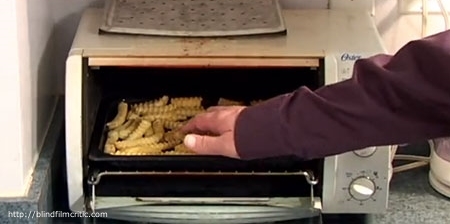
FOR THE VISUALLY IMPAIRED
Safe Cooking Cookware
A cooking pot for the visually impaired that promotes self reliance and confidence.
This versatile cooking pot consists of four parts: a ceramic outer shell that minimizes surface heat, a metal insert with a silicone rim for safe touching, a vented lid to prevent boil-overs, and a 2-in-1 steamer/strainer that expands cooking options while reducing the need for extra utensils.
High contrast colors identify parts and the base of the ceramic shell helps lock the pot onto a stove burner. The large, round, easy grip handle makes transport easier and help prevent injury.
RESEARCH
The Problem
People with visual impairments are at higher risk and experience more fear of receiving burns and scald while cooking around heating elements.
Vision Loss
21.1 MILLION AMERICAN ADULTS (18 and over) report experiencing vision loss... That number is expected to rise with the again of the Baby Boomers.
Vision loss refers to: having trouble seeing, even when wearing glasses or contact lenses, as well as blind or unable to see at all
• 20/200 to 20/400: severe visual impairment or legally blind
• 20/500 to 20/1,000: profound visual impairment or profound low vision
• More than 20/1,000: near-total blindness
• No light perception: total blindness
Cataracts
Glaucoma
Diabetic Retinopathy
Macular Degeneration
Burns
In the United States, there is an estimate of 450,000 CASES OF BURN INJURIES that receive medical treatment at hospital emergency department in 2012.
Leading causes of Burn Injuries
Leading Cause of Scalds
Leading Causes of Cooking Burn Injuries
Burn Taboos
Many people with and without vision loss, felt they shouldn't talk about first and / or second degree burns they received while cooking since they didn't result in hospital trips or treatment.
Demographics
Approximately 8.3 million Americans with vision loss are poor or near poor
Of 21.2 million American adults, 12.5 million women and 8.7 million men report experiencing significant vision loss
On average, 2/3 of people 65 and older report some vision loss
Nutrition
A healthy died consists of vegetables and whole grains
With the population of visually impaired poor or near poor as well as elderly, pasta, beans and vegetables are ideal, low cost, quick & easy to cook and provide needed nutrients
-Being able to steam and cook vegetables is key for older people who may also have teeth problems
User Interviews & Observational Research
Burns
"I haven't received a {bad] burn while cooking, just those ones that go aways in about 2 weeks."
Fatigue
"Forgetting which pots and pans are heated [can] be difficult, especially keeping track of hot handles."
"Draining water is so difficult, I just fish out my food and let the water cool."
Fear
"I don't cook very much because I am afraid of burns but I want to start cooking, it sounds fun and I think once I start, it won't be scary."
"It is scary to be near heat when you can't see"
Personal Experience
Cooking with safety glasses smeared in vaseline, for a month, to simulate low vision. Goal was to gain empathy and better understanding of physics and emotional hurdles associatied with cooking with low vision.
Key Takeaways
Lack of depth of field made searching for handles, utensils and food difficult and nerve racking
Getting hit with little bits of oil was not only painful but scary, not knowing how far away from the pot you are or where the handle is was never racking because you didn't want to knock over the pan or make sudden movements
It was extremely difficult to know when the food was done, resulting over cooked, hard, crispy burnt food
CONCEPTS
FINAL DESIGN
Black shell & lid used on white stoves, white shell & lid used on black stoves for best contrast.
Various handle, lid & pot rim colors available.
Concept & looks like prototype 2013 by Sara Linginfelter.
Photos are taken by the photographer Warren Rader.



